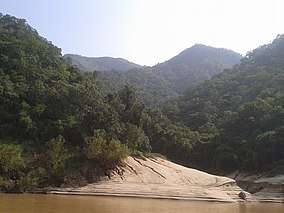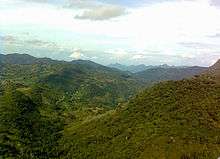Papikonda National Park
Papikonda National Park is located near Rajamahendravaram in the Papi Hills in East Godavari and West Godavari districts of Andhra Pradesh, and covers an area of 1,012.86 km2 (391.07 sq mi).[1][2] It is an Important Bird and Biodiversity Area and home to some endangered species of flora and fauna.[3] No part of Papikonda remains outside East and West Godavari districts after 2014 and after the construction of Polavaram Dam.
| Papikonda National Park | |
|---|---|
IUCN category II (national park) | |
 Papikonda National Park seen from Godavari River | |
| Location | Andhra Pradesh, India |
| Coordinates | |
| Area | 1,012.86 km2 (391.07 sq mi) |
History
Papikonda Wildlife Sanctuary was established in 1978.[4] It was upgraded to a national park in 2008.[3]
Geography
The national park's boundaries lie between 18° 49’ 20" N to 19° 18’ 14" N, 79° 54’ 13" E to 83° 23’ 35" E spread across the East and West Godavari districts of Andhra Pradesh. Its altitude ranges from 20 to 850 m (66 to 2,789 ft), and it receives an annual rainfall of 1168 mm. Godavari River flows through the park.[3]
Flora
The vegetation of Papikonda national park contains species of moist deciduous and dry deciduous forests.[4] Tree species include Pterocarpus marsupium, Terminalia elliptica, Terminalia arjuna, Adina cordifolia, Sterculia urens, Mangifera indica, Anogeissus latifolia.[3]
Fauna
Mammals
The mammals either sighted or recorded by camera traps includes Bengal tiger, Indian leopard, rusty-spotted cat, jungle cat, leopard cat, sloth bear, small Indian civet, Asian palm civet, wild boar and honey badger. Herbivores recorded include spotted deer, sambar deer, Indian muntjac, Indian spotted chevrotain, gaur, nilgai and four-horned antelope.[5]
The national park has population of both Rhesus macaque which are normally found north of Godavari and Bonnet macaque that are usually found south of Godavari. Gray langurs are also seen inside the national park.[3] The presence of water buffaloes in the area was recorded during the British imperial time.[6]
Birds
The national park was recognized as an Important Bird and Biodiversity Area by BirdLife International in 2016. Some of the endangered, vulnerable and near threatened species of birds reported includes Black-bellied tern, Pale-capped pigeon, Yellow-throated bulbul, Oriental darter, Pallid harrier, Great Thick-knee, River lapwing, River tern, Malabar pied hornbill, Alexandrine parakeet.
Some of the tropical moist forest species of birds sighted were Black-throated munia, Indian scimitar babbler, Jerdon's nightjar, Malabar trogon Malabar whistling thrush. A subspecies of Abbott's babbler identified and named after ornithologist K. S. R. Krishna Raju was sighted around the periphery of the national park.[7]
Reptiles
Indian golden gecko, endemic to the Eastern Ghats was reported from this national park.[8] King cobras were sighted in and around the protected area.[3][9]
Threats
The Polavaram irrigation project once completed will submerge parts of the national park.
Poaching, forest fires and clearing forest for podu cultivation were some of the threats.[3][10][11]
References
- "Wildlife Protected Areas Andhra Pradesh". 2014.
- "Papikonda Wildlife Sanctuary". AP forest department. Archived from the original on 25 January 2014. Retrieved 28 June 2014.
- Rahmani, A. R.; Islam, M. Z.; Kasambe, R. M. (2016). Important Bird and Biodiversity Areas in India: Priority Sites for Conservation (Revised and updated ed.). India: Bombay Natural History Society, Indian Bird Conservation Network, Royal Society for the Protection of Birds and BirdLife International U.K. pp. 206–208. ISBN 978-93-84678-02-9.
- Gujja, B.; Ramakrishna, S.; Goud, V.; Sivaramakrishna (2006). Perspectives on Polavaram, a Major Irrigation Project on Godavari. Academic Foundation. ISBN 9788171885787.
- Aditya, V.; Ganesh, T. (2017). "Mammals of Papikonda Hills, northern Eastern Ghats, India". Journal of Threatened Taxa. 9 (10): 10823–10830. doi:10.11609/jott.3021.9.10.10823-10830.
- Francis, W. (1989). Gazetteer of South India. 1. New Delhi: Mittal Publications. p. 270.
- Ripley, S. D.; Beehler, B. M. "A new subspecies of the babbler genus Malacocincla abbotti from the Eastern Ghats, India". Bulletin of the British Ornithologists' Club. 105 (2): 67.
- S.M., M. J.; Archana, W.; Tampal, F. (2007). "On the Occurrence of Golden Gecko (Calodactylodes aureus) in Papikonda Hills, Eastern Ghats, Andhra Pradesh, India" (PDF). Zoos' Print Journal. 22 (6): 2727–2729.
- Satyanarayana, J. E.; Balaji, K. (2018). "King Cobra: Occurrence of Ophiophagus hannah in Papikonda National Park, Eastern Ghats, Andhra Pradesh". Zoo's Print. 33 (3): 15–18.
- nilesh, v (25 June 2015). "Papikonda forest area shrinks, hunting on rise". Deccan Chronicle. Retrieved 27 December 2018.
- Ganesh, Thyagarajan; Aditya, Vikram (8 November 2018). "Deciphering forest change: Linking satellite-based forest cover change and community perceptions in a threatened landscape in India". Ambio. 48: 1–11. doi:10.1007/s13280-018-1108-x. ISSN 1654-7209. PMC 6509315. PMID 30406924.
External links
- Pakikonda National Park marked on OpenStreetMap



